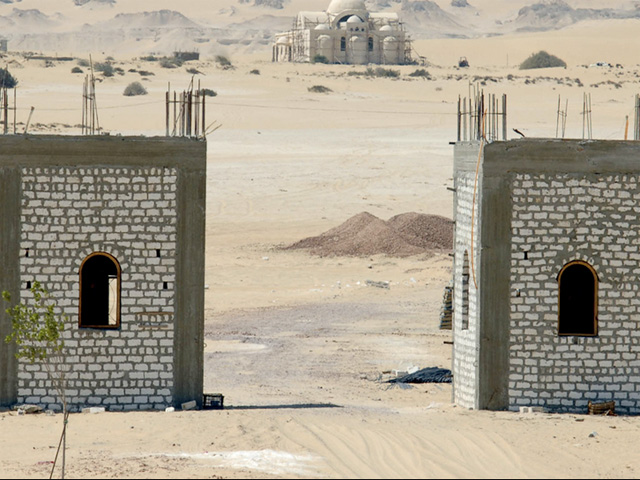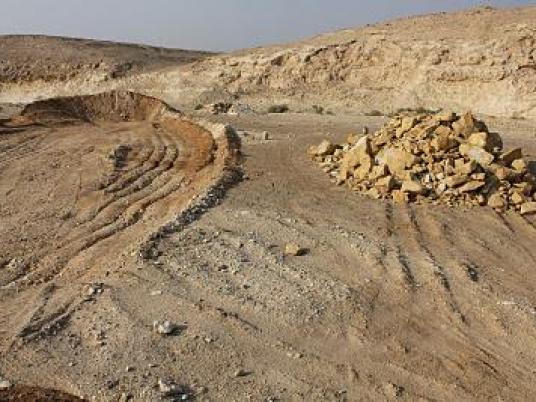Extending west over 30 kilometers from eastern Maadi to Ain al-Sokhna on the Red Sea, the Wadi Degla Protectorate is a natural geological formation threatened by encroaching urbanization and industrialization. Formed as a riverbed over 50 million years ago during the Eocene Age, this dry valley is presently endangered by the growing marble industry and destructive habits of some of its numerous visitors.
With an area of around 60 square kilometers Wadi Degla was designated as a protectorate in the year 1999 by the Egyptian Environmental Affairs Agency (EEAA). Despite its status, Wadi Degla is by no means immune to environmental threats.
Immediately outside the protectorate's entrance massive trenches containing sewage pipelines are currently undergoing installation. In previous years, a disturbing amount of garbage and plastic bags drifted into the protectorate from an adjacent garbage dump. The picturesque valley was strewn with plastic bags whenever the wind kicked-up–harming not only the natural beauty of the place, but also detrimentally affecting plant-life and animals found in the area.
Volunteer groups, including the local Tree-lovers Association, have in the past years moved in to pick up the airborne garbage and clean up the protectorate. In previous years, airborne waste landing within the protectorate engendered a serious problem but in 2010 the protectorate appears significantly cleaner as the airborne garbage problem has been resolved.
Authorities at the EEAA and the Wadi Degla Protectorate began to relocate the garbage dump site located at the eastern edge of the protectorate in 1999. Director of the Protectorate Tareq al-Qanawaty told Al-Masry Al-Youm that "the dump site, and an associated recycling center, were later relocated several kilometers eastwards towards Al-Qatamiya."
Although the garbage problem may have been resolved, Wadi Degla is said to be confronted with a more serious problem–the increasing number of marble and granite production factories and workshops found within the protectorate's buffer zone. This industry is directly associated with the quarrying sites in the nearby area of Shaq al-Thou'ban where some of the world's finest grades of marble and granite are reportedly found. Shaq al-Thou'ban is located near the protectorate, just outside its buffer zone, but the marble and granite factories are now located within the zone.
Around 80 factories and workshops operated within the buffer zone in 2006. Since then the number of these enterprises has nearly quadrupled to 300 factories and workshops.
According to Article Two of Law 102/1983 for Natural Protectorates, it is forbidden to partake in activities which lead to the destruction or deterioration of the natural environment. Such activities include the spoiling or destroying of geological structures (and other features) of areas serving as natural habitats and breeding areas for plants and animals. Pollution of the soil, water, or air of the protected area is also forbidden by this law.
According to Article Three of this law, it is prohibited to undertake activities in the areas surrounding designated protectorates, which will have an effect on the protectorates's environment and natures, except with the permission of the concerned administrative body. This permission was granted.
In 2006 a protocol between the Industrial Development Authority, the EEAA, and the Governorate of Cairo (Maadi and Wadi Degla are now administratively located within the newly created Governorate of Helwan) granted authorization for these factories and workshops to operate an estimated 800,000 square meters within the protectorate's buffer zone. Authorities and administrative bodies agreed to establish marble and granite production industries since they were deemed to be eco-friendly industries according to acceptable environmental standards.
The 300 some factories and workshops are currently located within the buffer zone, occupying an area of 835,000 square meters in the south of the protectorate. "We recently fenced off our buffer zone border so as to prevent these factories and workshops from encroaching upon the land of the protectorate itself," said Al-Qanawaty. According to the director factories use their industrial razors and water in their productions, no chemical waste products are released into the protectorates. "The direction of the wind is southerly, so the wind blows the dust from these factories away from the protectorate."
He admitted, however, that "industrial quarrying operations in the valleys around Wadi Degla have detrimentally affected the habitats of animals, and their movement to and from the area of this protectorate."
Mohammed Nagy, a specialist at the independent Habi Center for Environmental Rights, told Al-Masry Al-Youm "the presence of industrial operations of any sort within the buffer zone of any protectorate is alarming." According to Nagy, the marble and granite factories are encroaching onto the buffer zone of Wadi Degla, "because they are unable to establish these industries on adjacent lands which belong to the Ministry of Interior. The only direction in which they may expand their operations is towards the protectorate itself."
In response to the argument that the factories and workshops found in Wadi Degla's buffer zone are environmentally-friendly, Nagy said "marble and granite factories should not be referred to as being non-harmful, as they produce waste products, dust, and do in fact harm the surrounding habitats and eco-systems." He added that "by law, the only industries which should be allowed to function and exist within the buffer zone of an environmental protectorate are those industries which directly assist in the development and protection of the respective protectorate."
Nagy believes "the culture of protecting and safeguarding nature and natural protectorates is lacking in Egypt."
"I call on the authorities to immediately halt and entirely relocate these industries which are found within Wadi Degla's buffer zone," he urged.
Natural factors are also said to have left their impact on Wadi Degla. "Drought, and low levels of rainfall have left the protectorate dry and relatively lifeless, except for a few hardy desert plants and animals," said al-Qanawati, who described the valley as "resembling a natural seed bank." Indeed, after rainfall, Wadi degla is transformed into a greener, muddier and livelier valley.
The protectorate is said to host a multitude of fossils, 64 species of plant life, numerous species of insects, 20 species of reptiles, 12 species of birds, along with bats, and, less commonly, larger animals such as the rabbits, gazelles, foxes, tortoises. These larger animals are very rarely sited–many are endangered and some may have disappeared altogether. Professionals and volunteers, working in coordination with the Wadi Degla Protectorate, who are not affiliated with the EEAA, have also undertaken projects to safeguard wildlife in the valley, including bat populations found in the caves and caverns.
The first 12 kilometers–particularly the first 5–of the protectorate are the most frequently visited. The remaining 18 or so kilometers remain inaccessible to most visitors and their vehicles, as they require an off-road traverse approaching the protectorate from its southerly access points.
Wadi Degla remains a relatively popular getaway destination for biking, hiking, off-road driving, picnicking, camping, etc. However, driving off of designated tracks, camping in non-camp sites, the improper disposal of waste, and the deliberate or in-deliberate destruction of nature, have all left their tolls on Wadi Degla. The officials in charge of the protectorate have placed green trash cans along the winding trail, through the course of the canyon-like valley, at intervals of one can every half kilometer or so.
Despite the problems it faces, Wadi Degla remains an ideal location to enjoy the sun and natural silence.



